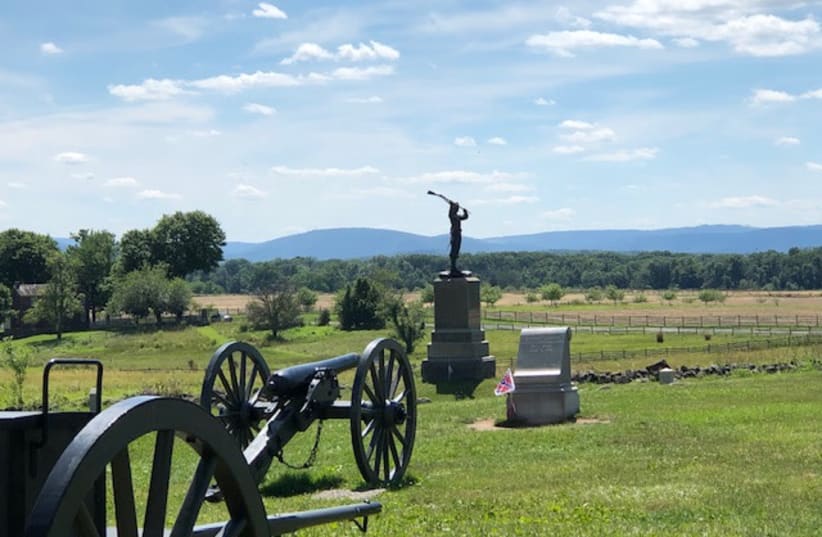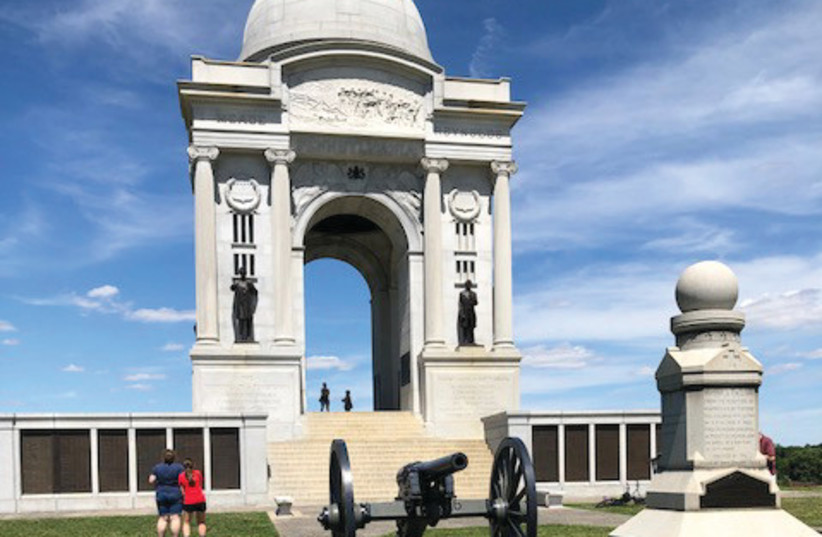Years ago, more than I care to remember, tryouts were held in my high school for commencement speaker.
For some reason, it was suggested that contestants shouldn’t recite Abraham Lincoln’s Gettysburg Address. I did anyway and won a spot on the speaker’s list at graduation.
It took me years to visit the crossroads town of Gettysburg in the rolling hills of Pennsylvania, the site of the most famous battlefield of the American Civil War, also known as the War between the North and the South, which lasted from 1861-1865.
Gettysburg is 141 miles from Philadelphia, eight miles north of the Maryland border. Arriving in the town of about 7,000 residents on a hot summer day in July, I immediately noticed the souvenir and antique shops, and motor lodges, much needed, for about a million visitors a year who tour the pivotal Civil War battlefield.
On my visit, I saw where President Abraham Lincoln, in dedicating the Soldier’s National Cemetery, gave his 272-word Gettysburg Address, four and a half months after the victorious Union victory on July 3, 1863.
Lincoln’s talk came to be seen as one of the greatest and most influential statements on the American national purpose. He said “that these dead shall not have died in vain – that this nation, under God, shall have a new birth of freedom – and that government of the people, by the people, for the people, shall not perish from the earth.”
Thirty-five hundred Northern soldiers are buried in the cemetery – out of 23,000 Northern troops who perished in this costliest battle in the American Civil War.
About 28,000 Southern troops died at Gettysburg. (More soldiers from both sides died in the four-year Civil War (620,000) than in all the wars following, including World Wars I and II, and up to the war in Afghanistan.)
EXCEPT FOR the monuments dedicated to fallen members of the Union and the Confederacy, artillery pieces and signposts, it’s hard to conjure up the fetid atmosphere and human slaughter of war that occurred here in the Pennsylvania countryside.
I couldn’t get over the stillness. Looking over the peaceful hills, golden with ripening grain, I imagine the artillery pieces pounding the enemy, the muzzle-loading rifles firing, the swords slashing during frontal charges – and always the screams of the wounded and moans of the dying.
There are many ways to tour the battlefield. Some hike. Some walk. Some go on private van tours and bus tours. Some drive around the battleground in their car with apps they download on their smartphones to guide them around the narrow roads to different sites.
A visitor soon learns the iconic names of Culp’s Hill, the Peach Orchard, Wheatfield, Devil’s Den, Little Round Top and Cemetery Ridge.
The battle at Gettysburg lasted three days, July 1-3, 1863, and determined the fate of the US as one nation. The two armies, the North (Union) commanded by George G. Meade, and the South, (Confederate) headed by Virginian Robert E. Lee, had stumbled into each other at Gettysburg.
Lee had invaded Pennsylvania, hoping to win a battle north of the Mason-Dixon line to force a negotiated end to the fighting. From the very beginning, the Union army held the high ground in the surrounding hills. For the first two days, Lee, whose army held the town itself, intended to rout the North by attacks on its flanks. But the bluecoats hurled back the rebels after the latter’s attack.
On the third day, Lee ordered a frontal attack to crush the Union center. One of his generals, James Longstreet, warned him not to attack, that it was an invitation to disaster, that the South could not take that strong position of the Union army as they were dug in on the top of the hills.
But Lee didn’t listen. He ordered Pickett to charge uphill and hit the Union army in its middle, which he figured was its weakest point.
On my visit I stood on Cemetery Ridge, and I wondered, how in the world Lee thought his men could run up that hill on a hot July day and overcome the strong Union defenses, which they had made impregnable the night before.
It was folly for the Southern commander to storm a position of great strength occupied by a numerically superior foe. But apparently Lee did not want to retreat from the area, it was bad for morale. He figured his men were invincible; they had not let him down up to this point in the war, they would repeat a victory.
And charge they did, the most famous being Pickett’s charge, named after Confederate Gen. George E. Pickett. The Union soldiers on the ridge waited until the rebels in tight line formation got close to the defense line and opened fire.
It is said that after that first barrage, a moan went up from the Southern soldiers that was heard by thousands at the scene. The rebels could not take the Yankee positions on Cemetery Ridge.
After the Confederates retreated down the blood-stained grassy hill, according to various Civil War historians, an unforgettable exchange took place between the Southern generals, Lee and Pickett, as the two prepared for a possible Union counterattack
“General Pickett, I want you to re-form your division in the rear of this hill,” said Lee.
Pickett’s eyes lighted as if a sudden pain had shot through him. He started to cry.
Lee said again with absolute calm, “General, you must look to your division.”
Pickett said tearfully, in a voice of a bewildered angry boy. “General Lee. I have no division.”
Lee is quoted by historian Shelby Foote as declaring, “It’s all my fault.” Defeated, Lee fled south with a wagon train of wounded soldiers straining toward the Potomac River and back to Virginia.
Union General Meade failed to pursue the retreating army, missing a critical opportunity to trap Lee and force a Confederate surrender. The loss at Gettysburg dashed the hopes of the Confederate States becoming an independent nation. The bitterly divisive war raged on for another two years.
Ten months before Lincoln’s powerful address at Gettysburg, he had issued the Emancipation Proclamation, which declared forever free those slaves within the Confederacy.
“Then as now,” recently wrote Carl M. Cannon, Washington bureau chief for RealClearPolitics, “America was undergoing a convulsive period of reckoning over the issue of racial justice.”
At Gettysburg, Lincoln had stated that the US was “conceived in Liberty, and dedicated to the proposition that all men are created equal.”
Cannon asks the question, “Can we (today) reconcile in time to avoid secession or massive social unrest, or... outright war.”
Leaving Gettysburg and its cemetery, one has to hope that America can reconcile, so that, in Lincoln’s words: “these dead shall not have died in vain.”
Ben G. Frank, journalist and lecturer, is the author of the just-published Klara’s Brother & The Woman He Loved, A Travel Guide to Jewish Europe 4th edition, and The Scattered Tribe: Traveling the Diaspora from Cuba to India to Tahiti & Beyond. Follow him at Twitter: @bengfrank

